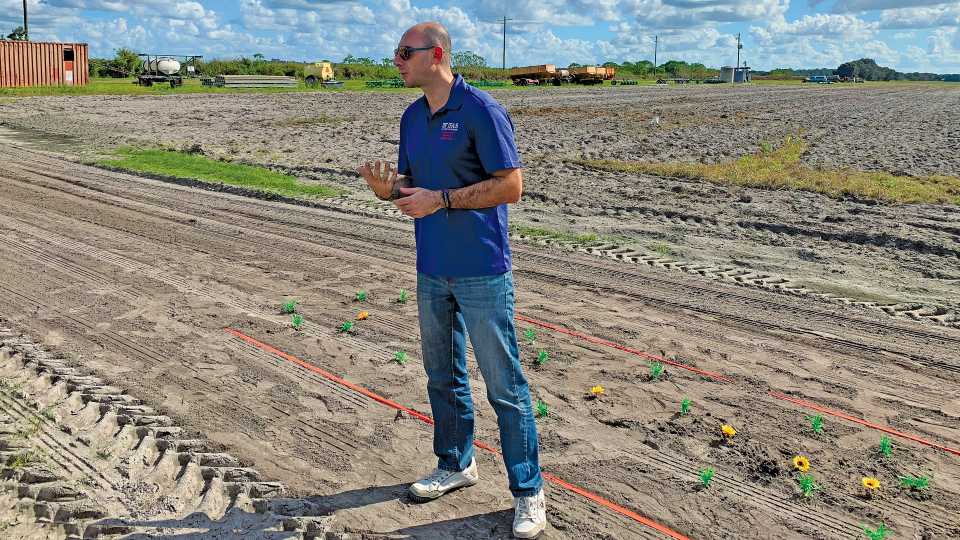How Artificial Intelligence Will Guide the Future of Agriculture

New automated harvesters like the Harvest CROO Robotics strawberry robot utilizes AI to capture images of ripe berries ready to pick.
Photo by Frank Giles
Artificial intelligence, or AI as it is more commonly called, has become more prominent in conversations about technology these days. But what does it mean? And how might it shape the future of agriculture?
In many ways, AI is already at work in agricultural research and in-field applications, but there is much more to come. Researchers in the field are excited about its potential power to process massive amounts of data and learn from it at a pace that far outstretches the capability of the human mind.
The newly installed University of Florida Vice President of Agriculture and Natural Resources, Scott Angle, sees AI as a unifying element of technology as it advances.
“Robotics, visioning, automation, and genetic breakthroughs will need advanced AI to benefit growers,” he says. “Fortunately, UF recognized this early on and is developing a program to significantly ramp up AI research at the university.”
What Is It and Where Did It Come From?
Jim Carroll is a global futurist who specializes in technology and explaining it in a way that non-computer scientists can understand. He says first and foremost, AI is not some out-of-control robot that will terrorize and destroy our way of life like it is often portrayed in the media and popular culture.
“This isn’t new,” Carroll says. “I actually found articles in Popular Mechanics magazine in the 1930s that spoke of ‘Giant Robot Brains’ that would steal all our jobs.
“What is AI, really? The best way to think about it is that it’s an algorithm at heart — it’s a computer that is really good at processing data, whether that be pure data, images, or other information. It has been ‘trained’ and ‘learns’ how to recognize patterns, trends, and insights in that information. The more it does it and gets the ‘right’ scores, the better it gets. It’s not really that scary.”
John McCarthy is considered one of the founding fathers of AI and is credited with coining the term in 1955. He was joined by Alan Turing, Marvin Minsky, Allen Newell, and Herbert Simon in the early development of the technology.
Back in 1955, AI entered the academic world as a new discipline, and in subsequent years has experienced momentum in fits and starts. The technology went through a phase of frozen funding some called the AI winter. Some of this was because AI research was divided into subfields that didn’t communicate with each other. Robotics went down one path while machine learning went down another. How and where would artificial neural networks be applied to practical effect?
But, as computing power has in-creased exponentially over time, AI, as Angle notes, is becoming a unifying technology that can tie all the subfields together. What once could only be imagined is becoming reality.
Ag Applications
Dr. Yiannis Ampatzidis, an Assistant Professor who teaches precision agriculture and machine learning at UF/IFAS, says applications are already at work in agriculture including imaging, robotics, and big data analysis.
“In precision agriculture, AI is used for detecting plant diseases and pests, plant stress, poor plant nutrition, and poor water management,” Ampatzidis says. “These detection technologies could be aerial [using drones] or ground based.”
The imaging technology used to detect plant stress also could be deployed for precision spraying applications. Currently, John Deere is working to commercialize a weed sprayer from Blue River Technology that detects weeds and applies herbicides only to the weed.
Ampatzidis notes AI is utilized in robotics as well. The technology is used in the blossoming sector of robot harvesters where it is utilized to detect ripe fruit for picking. Florida’s Harvest CROO Robotics is one example. Its robot strawberry harvester was used in commercial harvest during the 2019-2020 strawberry season in Florida.
Ampatzidis says AI holds great potential in the analytics of big data. In many ways, it is the key to unlocking the power of the massive amounts of data being generated on farms and in ag research. He and his team at UF/IFAS have developed the AgroView cloud-based technology that uses AI algorithms to process, analyze, and visualize data being collected from aerial- and ground-based platforms.
“The amount of these data is huge, and it’s very difficult for a human brain to process and analyze them,” he says. “AI algorithms can detect patterns in these data that can help growers make ‘smart’ decisions. For example, Agroview can detect and count citrus trees, estimate tree height and canopy size, and measure plant nutrient levels.”
Carroll adds there is so much data in imagery being collected today.
“An AI system can often do a better analysis at a lower cost,” he says. “It’s similar to what we are talking about in the medical field. An AI system can read the information from X-rays and be far more accurate in a diagnosis.”
The People Question
So, are robots and AI coming to steal all our jobs? That’s a complicated question yet to be fully played out as the technology advances. Ampatzidis believes the technology will replace repetitive jobs and ones that agriculture is already struggling to fill with human labor.
“It will replace jobs in factories, in agriculture [hand harvesters and some packinghouse jobs], vehicle drivers, bookkeepers, etc.,” Ampatzidis says. “It also will replace many ‘white-collar’ jobs in the fields of law, healthcare, accounting, hospitality, etc.
“Of course, AI also could develop new jobs in the area of computer science, automation, robotics, data analytics, and computer gaming.”
Carroll adds people should not fear the potential creative destruction brought on by the technologies enabled by AI. “I always tell my audiences, ‘Don’t fear the future,’” he says. “I then observe that some people see the future and see a threat. Innovators see the same future and see an opportunity.”

Yiannis Ampatzidis, an Assistant Professor who teaches precision agriculture and machine learning at UF/IFAS, says AI applications are already at work in agriculture.
Photo by Frank Giles
UF Scores Largest AI Supercomputer
In July, the University of Florida announced a $70 million public-private partnership with NVIDIA, a multinational technology company, to build the world’s fastest AI supercomputer in academia. The system will be operating in early 2021. UF faculty and staff will have the tools to apply AI in multiple fields, such as dealing with major challenges like rising sea levels, population aging, data security, personalized medicine, urban transportation, and food insecurity. UF expects to educate 30,000 AI-supporting graduates by 2030.
AlphaGo Illustrates AI’s Power
AlphaGo, a 2017 documentary film, probably does about as good a job as any in illustrating the potential power of AI. The film documents a team of scientists who built a supercomputer to master the board game “Go” that originated in Asia more than 3,000 years ago. It also is considered one of the most complex games known to man. The conventional wisdom was that no computer would be capable of learning the vast number of solutions in the game and the reasoning required to win.

The computer, AlphGo, not only mastered the game in short order — it took down human masters and champions of the game.
To learn more about the film, visit AlphaGoMovie.com.










